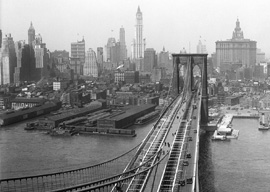
October 19, 2012

NEW YORK—It’s a black-and-white 1939 oldie starring Barbara Stanwyck and William Holden in his first credited film role. She is thin, ballsy, bawdy, beautiful, and talks with a Brooklyn accent. He’s tall, good-looking, and a professional boxer whose real love is playing the violin. He gives up the beak-busting business after he kills the Chocolate Drop Kid in the ring.
His name is Joe Bonaparte. Joe and Babs are on the roof of one of those Art Deco high-rises that gave New York the glamour of no other place on Earth. Gershwin’s syncopation can be heard in the distance while the two look down on the people going about their business. It’s night and the stars are out. Babs wants Joe to keep boxing and forget about the fiddle. “The little people never make it in this town,” she tells him. “What a girl wants is a man who can buy a car and give her what she wants.”
Those were the days. Apart from wearing a well-cut suit and dress, the lovers-to-be could actually go to a skyscraper’s roof and make whoopee to their hearts’ content. Golden Boy is not a particularly good movie, except for the quaint notion of a boxer also being a violinist and a woman leaving a rich older man for a poor younger one. Many years later, Bill Holden got up onstage and gave a wonderful speech thanking Barbara Stanwyck for giving him his break. (She had insisted he play the part of Joe.) She was a major, major star who always talked Brooklyn and went on acting until old age.
But back to the Art Deco. The New York skyline is the most photographed on Earth. It began with the mine-is-bigger-than-yours quest for stature by architects hired by tycoons whose egos knew no bounds. The exquisite Chrysler Building and Rockefeller Center come to mind. The superlatives piled higher after the Empire State Building reached for the sky. During a storm one small plane hit it somewhere toward the upper end, and a large gorilla perched himself in its turret. Otherwise the structure was fine, except for the dozens of suicides jumping off it year in and year out. (No longer. The place is easy to get into but impossible to jump off from.)
Then came the Twin Towers, two boxlike monsters who rose up during the ghastly seventies along with flared trousers, long hair, droopy mustaches, women with hairy armpits, and words such as “man” and “dude.” I always thought the Twin Towers typified the city’s lowest period: the race riots, the breakdown of law and order, and the encroaching proletarian brutalism. After 9/11 the Towers became a shrine.
At the beginning of the last century the first commercial towers boasted steel frames and limestone, as distinctly New York as the slate grey rooftops of Paris. The high-rise forest that the city became followed the stock market’s fluctuations, dipping low south of 34th Street in Manhattan during the Depression and reaching for the sky north of Midtown.